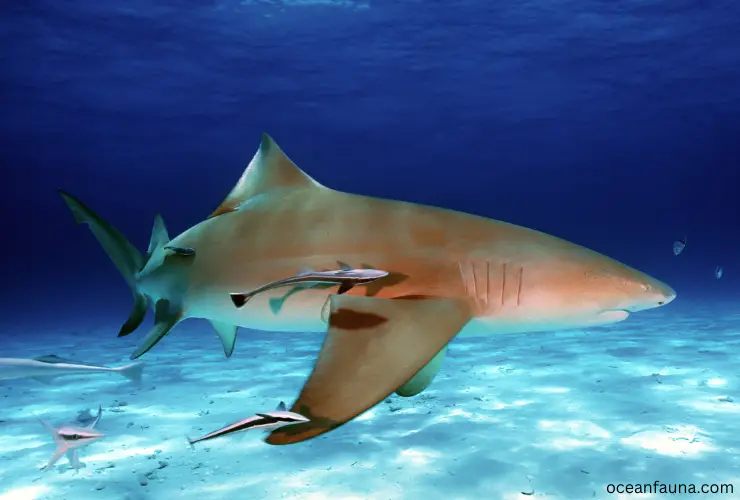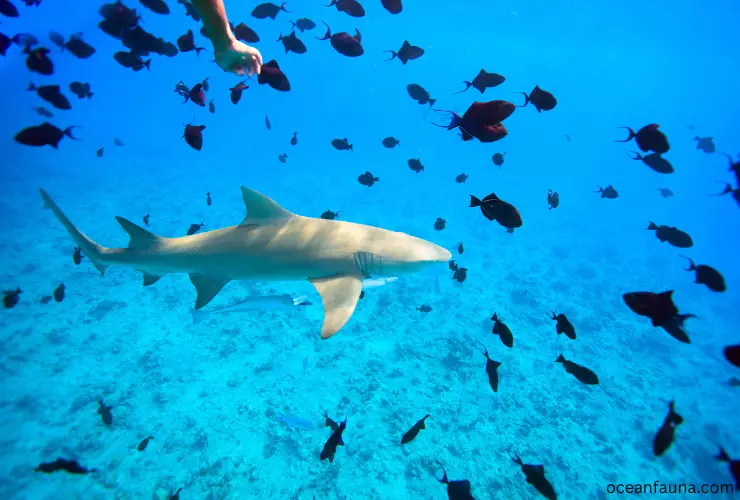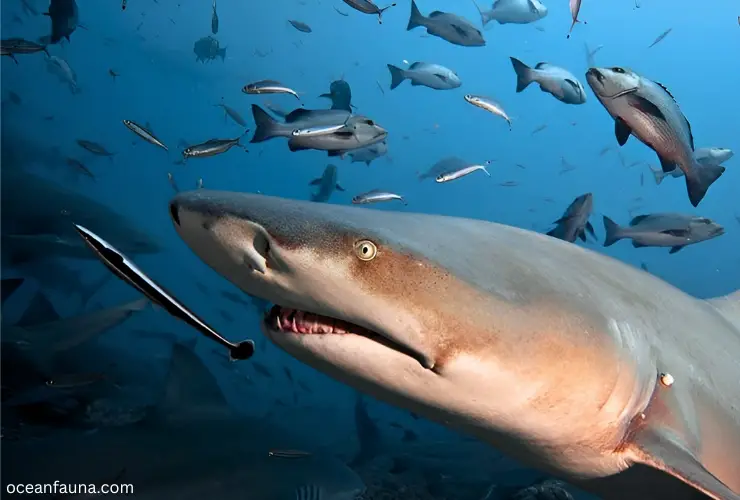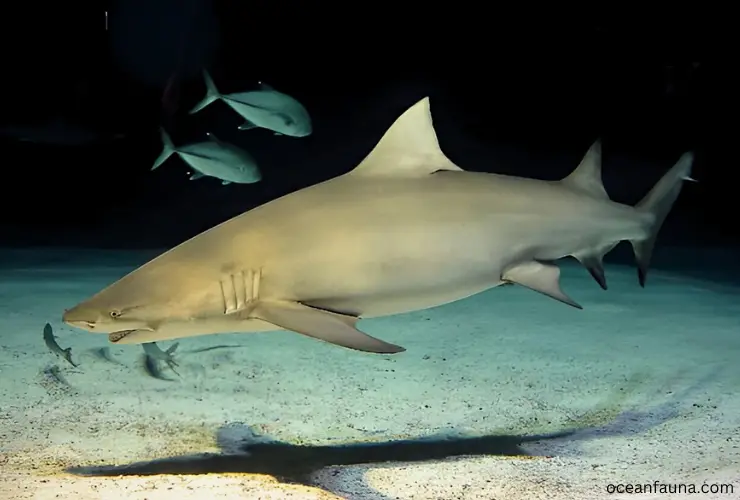Welcome to the world of Sicklefin Lemon Sharks (Negaprion acutidens). These fantastic creatures are some of the most fascinating sharks in existence. They have a unique anatomy that sets them apart from other species, and they can be found living in the oceans of the Indo-Pacific region.
In this blog post, I will discuss in detail this sicklefin lemon shark, including its anatomy and some other facts that you may not know.
About: Sicklefin Lemon Sharks
Before jumping into the details here is a chart to let you know about the Sicklefin lemon sharks. Have a look.
| Factor | Information |
| Common Name | Sicklefin Lemon Shark, Broadfin shark, Indian lemon shark, Indo-Pacific lemon shark, Shapnose lemon shark |
| Scientific Name | Negaprion acutidens |
| Kingdom | Animalia |
| Phylum | Chordata |
| Class | Chondrichthyes |
| Order | Carcharhiniformes |
| Family | Carcharhinidae |
| Habitat | Shallow coastal waters |
| Distribution | – Indo-Pacific, from South Africa to the Red Sea- Indian subcontinent to Southeast Asia |
| Conservation Status | Near Threatened (IUCN Red List) |
| Length (adult) | 12-13 ft |
| Weight (adult) | Up to 100 kg |
| Body Shape | Streamlined |
| Coloration | Gray to yellow-brow |
| Diet | Bony fish, squid, and crustaceans |
| Reproduction | Viviparous (gives birth to live young) |
| Gestation Period | 10 to 11 months |
| litter size | 6 to 12 pups |
| Lifespan | Up to 30 years |
| Predators | Larger sharks and humans |
| Behavior | Solitary or in small groups |
| Unique Features | Long sickle-shaped dorsal fin |
| Threats | Overfishing, habitat loss |
| Conservation Efforts | Protected in several marine protected areas and reserves |
Time to know more details about the “Sicklefin Lemon Sharks.”
The Sicklefin Lemon Shark is a species of requiem shark found in tropical and subtropical waters of the Atlantic, Pacific, and Indian Oceans. These sharks are gray to yellow-brown in color and can grow around 12-13 feet in length. They are known for their large second dorsal fin, which gives them a distinctively “sickle” shape.
Sicklefin Lemon Sharks feed primarily on bony fishes, including parrotfish, jacks, snappers, grunts, mullet, and herrings. However, they also hunt stingrays, shrimp, crabs, and squid when available. They prefer shallow waters close to the shore but have been spotted as far out as 350m into the open sea.
The Sicklefin Lemon Shark is listed as “Near Threatened” by IUCN due to its vulnerability to commercial fishing activities such as trawling and longlining. This species is also threatened by coastal development, which reduces their natural habitat and increases sedimentation from runoff into the water column.
Despite these threats, healthy populations live throughout its range, making it one of the most successful elasmobranchs worldwide.
Fun Facts: Sicklefin Lemon Sharks
- Sicklefin lemon sharks are most active at night and during twilight hours when they come closer to the surface to feed.
- They are able to detect electric fields generated by prey up to 0.8 m away from them.
- The sickle-shaped first dorsal fin of this species is diagnostic of its genus.
- Sicklefin lemon sharks have light-colored spiracles (respiratory openings behind the eyes) that make them easier to spot in deeper waters.
- The sicklefin lemon shark is listed as Near Threatened on the IUCN Red List and is protected by law in some countries.

Anatomy of Sicklefin Lemon Shark
General Anatomy
The Sicklefin Lemon Shark (Negaprion acutidens) has an elongated body with a pointed snout, relatively large eyes, low inter-dorsal ridges, and two dorsal fins, of which the first is tall and sickle-shaped.
The upper parts of its body are yellowish-brown while its underside is lighter. In size, adults can reach up to 12-13 feet (3.6–4 meters) in length and weigh around 220 pounds (100 kilograms).
Skeletal System
The skeleton of the Sicklefin Lemon Shark is composed of cartilage, allowing for flexibility and agility in movement due to the lack of bone weight associated with more rigid bony skeleton systems.
The skull consists primarily of five distinct sections, including the rostrum, frontals, parietals, temporal plates, and occipital plates.
Also Read: Zebra Shark: Habitat, Diet, Anatomy & Facts
They also have a jaw structure that includes three pairs of tooth-bearing bones: maxillae, premaxillae, and dentaries. These bones are supported by several gill arches, which form part of their respiratory system.
Musculoskeletal System
The muscles allow us to move by contracting and relaxing. This happens when nerve cells and muscle fibers talk to each other at places called neuromuscular junctions.
Along with this complex network, their bodies are full of strong connective tissues like collagen that link muscles to bones or organs like the heart muscle and help blood flow through their bodies. This system of bones and muscles helps them support their weight when they swim through water or glide across surfaces to hunt for food or get away from predators.
Circulatory System
Like many other species in the group Elasmobranchii, they have an open circulatory system that is mostly made up of a two-chambered heart. Some elasmobranchs have extra chambers that help them get more work done when they are active or under stress, like when they are chased or trying to escape.
This closed-loop circulatory system sends oxygenated blood through their bodies, giving them the nutrients they need for growth or the energy they need to do things like swim or mate. Thanks to hemoglobin-based respiration, these sharks can get oxygen from the water around them even if it isn’t dissolved in it.
Digestive System
The digestive system basically works the same way as any other vertebrate. Food goes into the stomach, where it is broken down further, and then into the intestines, where enzymes help break down proteins into amino acids.
These amino acids are then absorbed into cells, where they help with growth, repair, and other everyday tasks. Second, their large liver glands help them store fat energy reserves.
It lets them live without food for longer periods of time than other fish species can. These reserves help them get more energy when needed, especially when traveling long distances.
Reproductive System
Being dioecious means that males and females have different sexual organs, which means that eggs can be fertilized before they are born.
Both sexes have paired gonads on either side of their abdomens that release gametes every year depending on food availability, etc., and females also have uteri that can store embryos until the birthing season, which is usually in August or September.
Since Sicklefin Lemon Sharks reproduce internally, males don’t have any physical traits that help them stand out from females, as many land-based species do. This means that female Sicklefin Lemon Sharks must rely more on external stimuli signals, like pheromone production, when looking for mates.
What Do Sicklefin Lemon Sharks Eat?
The diet of sicklefin lemon sharks consists primarily of small bony fishes, such as anchovies, sardines, and herrings. They also feed on squid and crustaceans like shrimp and crabs. These species typically hunt in the upper layers of the water column, making them more visible to their prey.
Also Read: Pelagic Thresher Shark: Habitat, Diet, Anatomy & Fun Facts
They are also known to follow dolphins, sea turtles, and other larger marine predators to scavenge leftover prey.
Additionally, they have been observed preying upon juvenile sharks of their own or other species. In certain instances, sicklefin lemon sharks have also been observed taking advantage of fish aggregations for larger meals.
Where Do Sicklefin Lemon Sharks Live?
The Sicklefin Lemon Shark (Negaprion acutidens) is a species of requiem shark found in tropical and subtropical waters of the Pacific and Indian Oceans from coastal regions to depths of up to 180 m (590 ft).
It is commonly seen on coral reefs, sandy flats, lagoons, and shallow bays. This species prefers clear, warm waters with temperatures ranging from 20°C–27°C (68°F–81°F).
The Red Sea, the Indian Ocean, and the islands of Madagascar, Mauritius, and Seychelles to the north, the Philippines to the south, Vietnam to the north, and Australia to the south are all home to sicklefin lemon sharks. In addition to Taiwan, reports of it have come in from the Pacific islands of Palau, the Marshall Islands, and Tahiti.
Furthermore, this species can also be found in sheltered tidal creeks around mangrove forests or estuaries along the coastlines. Its range includes New Zealand’s Three Kings Islands.

Are Sicklefin Lemon Sharks Aggressive to a Human?
No, Sicklefin lemon sharks are generally not aggressive to humans. They have a relatively docile temperament and typically only become defensive if they feel threatened or provoked. There have been very few reported instances of Sicklefin lemon sharks acting aggressively toward humans.
This behavior has often been attributed to accidental contact with divers or divers entering the shark’s personal space. Aggression towards humans is more common in other species of sharks, such as Great White Sharks and Bull Sharks.
How Do Sicklefin Lemon Sharks Reproduce?
Sicklefin lemon sharks reproduce through a process called viviparity. This means that the shark embryo develops within the mother’s uterus and that a placental connection with the mother sustains its development.
In other words, the mother nourishes the unborn baby shark through a blood-rich placenta instead of an egg yolk sac, as would be the case in oviparous species.
The gestation period for these lemon sharks ranges from 10 to 11 months. When ready to give birth, female lemon sharks generally go to shallow coastal habitats (e.g., mangrove lagoons), where they find protection from predators and calmer waters in which to give birth.
Regarding breeding frequency, lemon sharks typically follow a biennial cycle (every two years). They usually mate between February and April, after which pregnancy can last up to 11 months.
When born, baby lemon sharks are about 40-50 cm in length and weigh approximately 200-250 grams at most. On average, each litter contains 9.3 babies (ranges 6-12), although larger litter has been reported in some cases.
What Is the Lifespan of Sicklefin Lemon Sharks?
The lifespan of sicklefin lemon sharks (Negaprion acutidens) is not well documented. However, they are thought to live a similar length of time as their close relative, the lemon shark (Negaprion brevirostris), which typically lives between 20 and 30 years in the wild.
Sicklefin lemon sharks may even live longer than this because they inhabit deeper waters than other species of lemon shark. However, there is little scientific research or literature on this species’ longevity, and lifespan in captivity has yet to be studied.

Threats and Caution: Sicklefin Lemon Sharks
Threats to the sicklefin lemon shark are primarily due to overfishing, particularly in its core range, including India and Southeast Asia. This unsustainable fishing has led to severe species depletion, with some local populations being completely wiped out.
Furthermore, their low reproductive productivity and slow rate of movement further hamper their ability to recover from such significant losses.
Due to their current status as an Endangered species, caution must be taken when approaching or interacting with them. In order to ensure their survival, fishing regulations must be established and implemented strictly in areas where they reside.
Additionally, greater efforts should be made towards educating local communities about the importance of conserving these animals in order for them to successfully recover from the brink of extinction that they are currently facing.
Conclusion
Hopefully, you have a broad knowledge of the sicklefin lemon sharks, including diet, habitat, lifespan, and interesting facts. Also, due to their endangered status, we must be cautious when interacting with them and support conservation efforts to ensure their survival.
With the right protections and proper education about their importance to our ecosystems, these animals will have a fighting chance at recovery.


2 thoughts on “Sicklefin Lemon Shark: Habitat, Diet, Anatomy & Fun Facts”